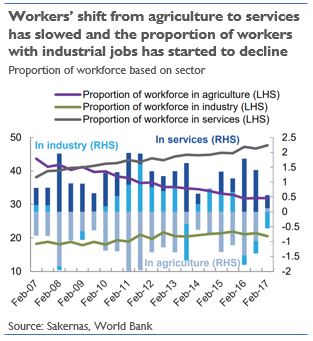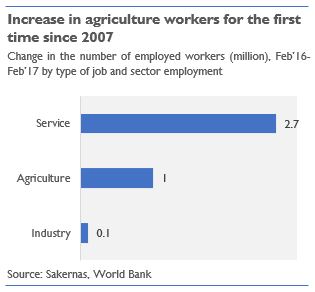Job data signals improving conditions for Indonesian farmers
Job data signals improving conditions for Indonesian farmers


In our reports, we have been arguing that one area that’s less prone to digital disruption is the farming sector. In one of our key markets, Indonesia, the digital revolution has actually helped the sector rather than disrupting it.
With farmers having better access to information about prices of rice, corn, and chilli for example, they can maximize their selling price. Also, the agricultural reform of Indonesia’s current government has been running for about two years now. Many initiatives have been undertaken, but communicating these to the farmers is a challenge on its own.
We learned from our many trips across Indonesia that a big majority of the farmers are not really using smartphones. However, better network coverage and a big push in rural Indonesia from Chinese phone makers like OPPO is gradually changing the landscape.
We have witnessed how the Indonesian government has adapted and learned to use social media to broadcast the programs on agricultural reform. One example is the campaign to push a farmer insurance program designed to protect farmers from losses resulting from floods and pests (see add here).
There are anecdotes that this insurance program has been very effective this year since many farm-lands were affected by various kind of pests. The farmer insurance program helps to keep farmers’ planting appetite strong and helps to avoid farmers resorting to loan sharks for a “solution” to their financial woes.
What we would like to stress is that this insurance program is just one of the many components of the Indonesian agricultural reform aimed at improving farmers’ welfare. Except for rising production output and declining poverty levels in villages, new job data from The Central Statistics Agency (BPS) Indonesia also seem to indicate that the farming sector is benefitting.
Shift of workers from agri to service industry slowed down
As yet another indicator of the success of the program, we would like to point out a chart (see below) from Indonesian national labour force survey, Sakernas. The survey suggests that for the first time in a decade, workers’ shift from agriculture to service industry has slowed.
More jobs added in agri than in industry sector
Another chart (see below) from the same institution suggests that, in contrary to common belief, the number of employed workers in the agriculture sector has increased by 1mn in the period from Feb 2016 to Feb 2017. The addition is multiple times the size of addition in the manufacturing sector.
Unemployment rate in villages (=farmers) declined further
Based on data from the Indonesian statistics agency, the unemployment rate in the villages has been on the way down, from 4.35% in Feb 2016 to 4.01% in August 2017. During our trip to the villages, farmers informed us that it is generally difficult to find workers to help them during the harvest time.
We expect the trend of falling unemployment in Indonesian rural areas to continue given that various ministry-level proposals have been made aiming to incentivise people to stay and work in the villages.
No doubt that, reflecting the economic reality in the villages, a vast majority of these proposals will impact the farming area.
As the numbers are hard to argue with, we trust that investors should be more open-minded about the success of the Indonesian agricultural reform.
Admin heyokha
Share
In our reports, we have been arguing that one area that’s less prone to digital disruption is the farming sector. In one of our key markets, Indonesia, the digital revolution has actually helped the sector rather than disrupting it.
With farmers having better access to information about prices of rice, corn, and chilli for example, they can maximize their selling price. Also, the agricultural reform of Indonesia’s current government has been running for about two years now. Many initiatives have been undertaken, but communicating these to the farmers is a challenge on its own.
We learned from our many trips across Indonesia that a big majority of the farmers are not really using smartphones. However, better network coverage and a big push in rural Indonesia from Chinese phone makers like OPPO is gradually changing the landscape.
We have witnessed how the Indonesian government has adapted and learned to use social media to broadcast the programs on agricultural reform. One example is the campaign to push a farmer insurance program designed to protect farmers from losses resulting from floods and pests (see add here).
There are anecdotes that this insurance program has been very effective this year since many farm-lands were affected by various kind of pests. The farmer insurance program helps to keep farmers’ planting appetite strong and helps to avoid farmers resorting to loan sharks for a “solution” to their financial woes.
What we would like to stress is that this insurance program is just one of the many components of the Indonesian agricultural reform aimed at improving farmers’ welfare. Except for rising production output and declining poverty levels in villages, new job data from The Central Statistics Agency (BPS) Indonesia also seem to indicate that the farming sector is benefitting.
Shift of workers from agri to service industry slowed down
As yet another indicator of the success of the program, we would like to point out a chart (see below) from Indonesian national labour force survey, Sakernas. The survey suggests that for the first time in a decade, workers’ shift from agriculture to service industry has slowed.
More jobs added in agri than in industry sector
Another chart (see below) from the same institution suggests that, in contrary to common belief, the number of employed workers in the agriculture sector has increased by 1mn in the period from Feb 2016 to Feb 2017. The addition is multiple times the size of addition in the manufacturing sector.
Unemployment rate in villages (=farmers) declined further
Based on data from the Indonesian statistics agency, the unemployment rate in the villages has been on the way down, from 4.35% in Feb 2016 to 4.01% in August 2017. During our trip to the villages, farmers informed us that it is generally difficult to find workers to help them during the harvest time.
We expect the trend of falling unemployment in Indonesian rural areas to continue given that various ministry-level proposals have been made aiming to incentivise people to stay and work in the villages.
No doubt that, reflecting the economic reality in the villages, a vast majority of these proposals will impact the farming area.
As the numbers are hard to argue with, we trust that investors should be more open-minded about the success of the Indonesian agricultural reform.
Admin heyokha
Share

















